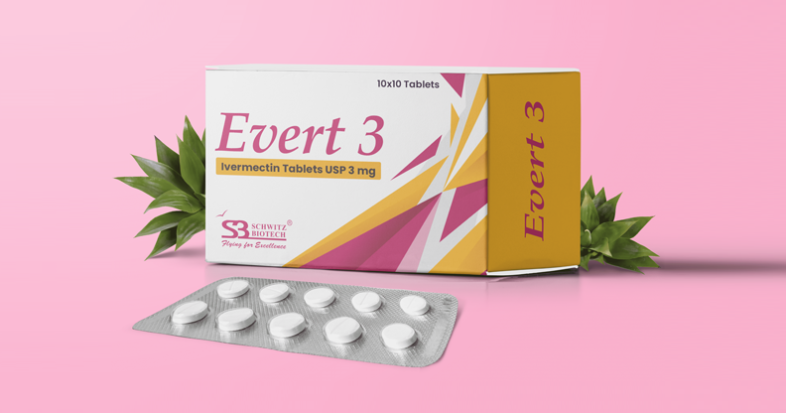IVERMECTIN TABLETS 3MG

DESCRIPTION
IVERMECTIN TABLETS USP 3 MG is a semisynthetic, anthelmintic agent for oral administration. Ivermectin is derived from the avermectins, a class of highly active broad-spectrum, anti-parasitic agents isolated from the fermentation products of Streptomyces avermitilis.
CLINICAL PHARMACOLOGY
Pharmacokinetics
Following oral administration of IVERMECTIN, plasma concentrations are approximately proportional to the dose. In two studies, after single 12-mg doses of IVERMECTIN TABLETS in fasting healthy volunteers (representing a mean dose of 165 mcg/kg), the mean peak plasma concentrations of the major component (H2B1a) were 46.6 (±21.9) (range: 16.4-101.1) and 30.6 (±15.6) (range: 13.9-68.4) ng/mL, respectively, at approximately 4 hours after dosing.
Ivermectin is metabolized in the liver, and ivermectin and/or its metabolites are excreted almost exclusively in the feces over an estimated 12 days, with less than 1% of the administered dose excreted in the urine.
The plasma half-life of Ivermectin in man is approximately 18 hours following oral administration. The safety and pharmacokinetic properties of Ivermectin were further assessed in a multiple-dose clinical pharmacokinetic study involving healthy volunteers. Subjects received oral doses of 30 to 120 mg (333 to 2000 mcg/kg)
Ivermectin in a fasted state or 30 mg (333 to 600 mcg/kg) Ivermectin following a standard high-fat (48.6 g of fat) meal. Administration of 30 mg ivermectin following a high-fat meal resulted in an approximate 2.5¬ fold increase in bioavailability relative to administration of 30 mg Ivermectin in the fasted state. In vitro studies using human liver microsomes and recombinant CYP450 enzymes have shown that ivermectin is primarily metabolized by CYP3A4. Depending on the in vitro method used, CYP2D6 and CYP2E1 were also shown to be involved in the metabolism of Ivermectin but to a significantly lower extent compared to CYP3A4. The findings of in vitro studies using human liver microsomes suggest that clinically relevant concentrations of Ivermectin do not significantly inhibit the metabolizing activities of CYP3A4, CYP2D6, CYP2C9, CYP1A2, and CYP2E1.
Microbiology IVERMECTIN is a member of the avermectin class of broad-spectrum Antiparasitic agents which have a unique mode of action. Compounds of the class bind selectively and with high affinity to glutamate-gated chloride ion channels which occur in invertebrate nerve and muscle cells. This leads to an increase in the permeability of the cell membrane to chloride ions with hyperpolarization of the nerve or muscle cell, resulting in paralysis and death of the parasite. Compounds of this class may also interact with other ligand-gated chloride channels, such as those gated by the neurotransmitter gamma-aminobutyric acid (GABA). The selective activity of compounds of this class is attributable to the facts that some mammals do not have glutamate-gated chloride channels and that the avermectins have a low affinity for mammalian ligand-gated chloride channels. In addition, ivermectin does not readily cross the blood-brain barrier in humans.
Ivermectin is active against various life-cycle stages of many but not all nematodes. It is active against the tissue microfilariae of Onchocerca volvulus but not against the adult form. Its activity against Strong yloidesstercoralis is limited to the intestinal stages.
Ivermectin is metabolized in the liver, and ivermectin and/or its metabolites are excreted almost exclusively in the feces over an estimated 12 days, with less than 1% of the administered dose excreted in the urine.
The plasma half-life of Ivermectin in man is approximately 18 hours following oral administration. The safety and pharmacokinetic properties of Ivermectin were further assessed in a multiple-dose clinical pharmacokinetic study involving healthy volunteers. Subjects received oral doses of 30 to 120 mg (333 to 2000 mcg/kg)
Ivermectin in a fasted state or 30 mg (333 to 600 mcg/kg) Ivermectin following a standard high-fat (48.6 g of fat) meal. Administration of 30 mg ivermectin following a high-fat meal resulted in an approximate 2.5¬ fold increase in bioavailability relative to administration of 30 mg Ivermectin in the fasted state. In vitro studies using human liver microsomes and recombinant CYP450 enzymes have shown that ivermectin is primarily metabolized by CYP3A4. Depending on the in vitro method used, CYP2D6 and CYP2E1 were also shown to be involved in the metabolism of Ivermectin but to a significantly lower extent compared to CYP3A4. The findings of in vitro studies using human liver microsomes suggest that clinically relevant concentrations of Ivermectin do not significantly inhibit the metabolizing activities of CYP3A4, CYP2D6, CYP2C9, CYP1A2, and CYP2E1.
Microbiology IVERMECTIN is a member of the avermectin class of broad-spectrum Antiparasitic agents which have a unique mode of action. Compounds of the class bind selectively and with high affinity to glutamate-gated chloride ion channels which occur in invertebrate nerve and muscle cells. This leads to an increase in the permeability of the cell membrane to chloride ions with hyperpolarization of the nerve or muscle cell, resulting in paralysis and death of the parasite. Compounds of this class may also interact with other ligand-gated chloride channels, such as those gated by the neurotransmitter gamma-aminobutyric acid (GABA). The selective activity of compounds of this class is attributable to the facts that some mammals do not have glutamate-gated chloride channels and that the avermectins have a low affinity for mammalian ligand-gated chloride channels. In addition, ivermectin does not readily cross the blood-brain barrier in humans.
Ivermectin is active against various life-cycle stages of many but not all nematodes. It is active against the tissue microfilariae of Onchocerca volvulus but not against the adult form. Its activity against Strong yloidesstercoralis is limited to the intestinal stages.
INDICATIONS AND USAGE
IVERMECTIN TABLET is indicated for the treatment of the following infections: Strongyloidiasis of the intestinal tract. IVERMECTIN TABLET is indicated for the treatment of intestinal (i.e., nondisseminated) strongyloidiasis due to the nematode parasite Strongyloidesstercoralis. This indication is based on clinical studies of both comparative and open-label designs, in which 64-100% of infected patients were cured following a single 200-mcg/kg dose of ivermectin.
Onchocerciasis. IVERMECTIN TABLET is indicated for the treatment of onchocerciasis due to the nematode parasite Onchocerca volvulus. This indication is based on randomized, double-blind, placebo-controlled and comparative studies conducted in 1427 patients in onchocerciasis-endemic areas of West Africa. The comparative studies used diethylcarbamazine citrate (DEC-C).
Onchocerciasis. IVERMECTIN TABLET is indicated for the treatment of onchocerciasis due to the nematode parasite Onchocerca volvulus. This indication is based on randomized, double-blind, placebo-controlled and comparative studies conducted in 1427 patients in onchocerciasis-endemic areas of West Africa. The comparative studies used diethylcarbamazine citrate (DEC-C).
CONTRAINDICATIONS
IVERMECTIN TABLET is contraindicated in patients who are hypersensitive to any component of this product.
WARNINGS
Historical data have shown that microfilaricidal drugs, such as diethylcarbamazine citrate (DEC-C), might cause cutaneous and/or systemic reactions of varying severity (the Mazzotti reaction) and ophthalmological reactions in patients with onchocerciasis.
These reactions are probably due to allergic and inflammatory responses to the death of microfilariae. Patients treated with IVERMECTIN TABLET for onchocerciasis may experience these reactions in addition to clinical adverse reactions possibly, probably, or definitely related to the drug itself.
These reactions are probably due to allergic and inflammatory responses to the death of microfilariae. Patients treated with IVERMECTIN TABLET for onchocerciasis may experience these reactions in addition to clinical adverse reactions possibly, probably, or definitely related to the drug itself.
PRECAUTIONS
General After treatment with microfilaricidal drugs, patients with hyperreactiveonchodermatitis (sowda) may be more likely than others to experience severe adverse reactions, especially edema and aggravation of onchodermatitis. Rarely, patients with onchocerciasis who are also heavily infected with Loa loa may develop a serious or even fatal encephalopathy either spontaneously or following treatment with an effective microfilaricide.
ADVERSE REACTIONS
Laboratory Test Findings In controlled clinical trials, the following laboratory adverse experiences were reported as possibly, probably, or definitely related to the drug in ≥1% of the patients: eosinophilia (3%) and hemoglobin increase (1%).
POST-MARKETING EXPERIENCE
The following adverse reactions have been reported since the drug was registered overseas: Onchocerciasis
Conjunctival hemorrhage Hypotension (mainly orthostatic hypotension), worsening of bronchial asthma, toxic epidermal necrolysis ,Stevens-Johnson syndrome, seizures, hepatitis, elevation of liver enzymes, and elevation of bilirubin.
DOSAGE AND ADMINISTRATION
The recommended dosage of IVERMECTIN TABLET for the treatment of strongyloidiasis is a single oral dose designed to provide approximately 200 mcg of ivermectin per kg of body weight. See Table 1 for dosage guidelines. Patients should take tablets on an empty stomach with water.
DOSAGE GUIDELINES FOR IVERMECTIN TABLET FOR STRONGYLOIDIASIS
| Body Weight (kg) | Single Oral Dose Number of 3-mg Tablets |
| 15-24 | 1 tablet |
| 25-35 | 2 tablets |
| 36-50 | 3 tablets |
| 51-65 | 4 tablets |
| 66-79 | 5 tablets |
| ≥80 | 200 mcg/kg |
OVERDOSAGE
Significant lethality was observed in mice and rats after single oral doses of 25 to 50 mg/kg and 40 to 50 mg/kg, respectively. No significant lethality was observed in dogs after single oral doses of up to 10 mg/kg.
STORAGE
- Store below 25°C in a dry place in original package.
- Do not use later than the date of expiry.
- Keep out of reach of children.
PRESENTATION
- 10 Blisters of 10 Tablets in a Box.

